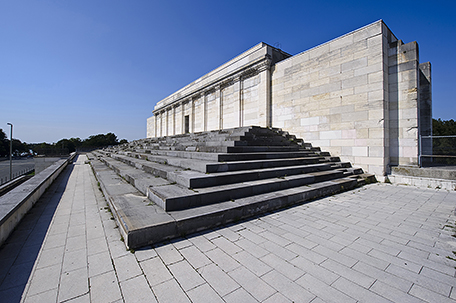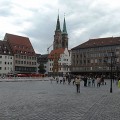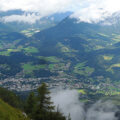
ABOVE PHOTO: Nazi Party Rally Grounds
By Renée S. Gordon
“O how small a portion of earth will hold us when we are dead, who ambitiously seek after the whole world while we are living.”
–Philip II of Macedonia
Roman Emperor and King of Germany, Henry IV, granted Nuremberg the right to coin money in 1062, Emperor Frederick II declared it a free Imperial City in 1219 and in 1356 the Golden Bull declared that each new king was obliged to hold his first parliament there. It became increasingly more important as a trade and mercantile city and gained prominence for its art and architecture, becoming a center of the German Renaissance. Filled with half-timbered houses and winding lanes, Nuremberg resembled a medieval city preserved in amber when world events closed in. www.germany.travel/en
It was Nuremberg’s imperial past and medieval German esthetic appeal that would place it squarely at the heart of the country’s history in the mid-1900s for good and ill. Hitler called it “the most German of German cities” and the Nazis brought together the masses and used it as a backdrop for the creation of the Messianic Fuhrer. For many of the same reasons Nuremberg was selected as the location for the post-war Nuremberg Trials. A number of the sites still stand as well as an outstanding Documentation Center that allows visitors to more fully understand the events leading up to WWII and its aftermath. Guided tours are available as well as maps and information on self-guided tours. www.tourismus.nuernberg.de
In 1424, Emperor Sigismund ruled that the Holy Roman Empire’s Crown Jewels be kept permanently in Nuremberg. Prior to this decree the royal regalia was always in the possession of the emperor. The jewels were stored there until 1796 when they were sent to Vienna to prevent their confiscation by Napoleon. Hitler had them returned from Vienna’s Kunsthistoriches Museum in 1938 because he wanted to establish himself as a legitimate heir to the Holy Roman Empire. He attended the ceremony celebrating the return of the crown, orb, scepter, lance and imperial sword held in St. Catherine’s Church. During the war they were stored in the bunker beneath the castle where they were discovered by American forces in 1945. The Americans, not wanting the regalia to become objects of veneration, sent them to Vienna’s Hofburg. St. Catherine’s is now in ruins as a result of the bombings and it is a summer setting for outdoor concerts.
The Grand Hotel is situated directly across from the main train station and is accessible to all the city sites either by public transit or walking. The hotel was family owned and they refused Hitler a room in the 1920s because they disagreed with his politics. He never tried to stay there again. While the Nuremberg Trials were taking place several of the judges lodged there. Built in 1897, it is considered one of the world’s greatest hotels. www.lemeridiennuernberg.com/en
Hotel Deutscher Hof, also centrally located near the train station, was Hitler’s hotel of choice whenever he visited the city. He is known to have stayed in suite 105 at least once.
The NSDAP (Nazi Party) rallies (Reichsparteitag) were a series of yearly gatherings, attended by thousands of Germans, that advanced the party agenda with a conspicuous display of military might, national pride and policy pronouncements. The first rally was held in 1923 followed by a second in 1926. As the party rose to power the rallies became increasingly flamboyant and went on longer. Eventually they became annual and from 1933-38 they were held in Nuremberg. They were each themed and were held until Hitler’s 1939 invasion of Poland. The 1939 cancelled Reichsparteitag was themed, “The Rally of Peace.” The most infamous of these extravaganzas was held in 1935. On this occasion the Nuremberg Race Laws were issued that took away many of the rights of the Jews, marginalized them and legalized the steps that led to the Holocaust.
Leni Riefenstahl filmed the propaganda movie Triumph of the Will in 1934. The film is a masterwork of propaganda and was created to present Hitler as a mythic figure who was destined to save the country. The opening image is one of clouds parting as Hitler’s plane descends over Nuremberg. The crowds are huge but individuals are not spotlighted because individualism was not encouraged. Everything was for the good of the party, the country and the political agenda. Her film is available on Youtube.
Grandiose aspirations require ostentatious settings and to that end Hitler selected architect Albert Speer to design a series of buildings in a 6.83-sq. mile complex in which to hold events including the Reichsparteitag. Zeppelin Field is the most recognized of these sites because the image of the Allies blowing up the large, gold-plated, swastika on the top of it in 1945 has been broadcast around the globe. The 1200-ft. grandstand’s design was based on the second-century Pergamon Altar. Thirty-six light towers with six flags each and more than 100 anti-aircraft spotlights illuminated the field as Hitler addressed the crowd from a limestone tribune. More than 190,000 people could be seated in the grandstands. Golden Hall, notable for its gold mosaics and cast iron door, was located below the VIP seating section. Zeppelin Field Rally Grounds was constructed between 1934-37. In 1945, the US Army held a victory parade there culminating in the obliteration of the swastika. The field is open for tours.
Access to the complex was obtained via the Great Road, also a Speer design. The granite-paved boulevard was 200-ft. wide and approximately ¾-mile long and allowed the people to see both the Nazi complex and the castle, linking Hitler visually with the Germanic past. The road was never used for its original purpose but still exists and is used for parking.
Congress Hall was to have been the most significant structure in the complex. It was designed after the Roman Coliseum but was to have been larger than the original. It was never completed and the walls only reached 120-ft. In 1973 it was declared a historic monument and today the north wing integrates the structure and the history of the era in the Nuremberg Documentation Center.
Part of the complex had been a POW camp. After it was liberated in April of 1945 it was used as an internment site for former leaders of the Nazi party and members of the SS.
A conscious decision was made not to refer to the Documentation Center as a museum so as not to glorify Hitler or the Nazi Regime. Additionally, no Nazi memorabilia is on display but the center’s goal is attained through state-of-the-art displays, photographs, first person testimony and films within the 4265-sq. ft., 19 chronological galleries, and exhibition space. Primary among those goals is to facilitate n understanding and recognition of the process of radicalization of an average society and how that process impacts on the modern era. Special exhibits are mounted as well as the outstanding permanent exhibit, “Fascination and Terror,” Tours begin with a 7-minute film and proceed through galleries featuring German and European history 1923-45. Rooms 1-5, focus on all aspects of the Nazi rise to power and rooms 6-17, the rallies, WWII and the Holocaust. The final two rooms are devoted to the Nuremberg Trials.
The center also serves as an educational center ensuring that this type of event does not repeat itself and paving the way for people to understand the importance of human rights. Every school student, police officer and soldier is required to spend time studying in the center. Nuremberg was awarded the 2000 UNESCO Prize for Human Rights Education. www.museums.nuremberg.de/documentation-centre/index.html
Gutmann am Dutzendteich is located on a lake with a perfect view of the Documentation Center. Everything about this restaurant is wonderful, the food, the hospitality and the atmosphere. It offers a traditional menu. www.gutmann-am-dutzendteich.de
In 1943 Churchill, Roosevelt and Stalin signed the Moscow Declaration stating that any atrocities committed by the Axis powers would be punishable after WWII. On August 8, 1945 the four Allied powers signed the Agreement for the Prosecution and Punishment of the Major War Criminals of the European Axis Powers stating that Axis leaders would be tried in Nuremberg, those of lesser rank would be tried in the 4 occupied zones, and instituted an International Military Tribunal with a panel of eight judges, two from each of the allies. Each defendant was entitled to choose an attorney. This trial was the first time simultaneous translations were used as interpreters translated into English, French, German and Russian as testimony was given.
Nuremberg was selected as the venue for the trials of the most important criminals because it had been the location of the Nazi Party rallies, it was felt that this choice would make a strong statement regarding the war’s end and it was in the Western Zone. During the war years Nuremberg had been responsible for the production of nearly 50% of the country’s airplanes and submarines and as a result more than 90% of the city was destroyed by allied bombings. The Palace of Justice was not destroyed, the 530 offices and 80 courtrooms are large enough to hold the trials and there was an adjacent prison for more secure inmate incarceration.
All the trials were held in Nuremberg from 1945-49. The trials with which we are most familiar were held from November 20, 1945 to October 1, 1946. The first trial included twenty-four defendants, including Goring and Speer, the highest-ranking men who remained alive. They were indicted on 4 counts, participation in a common plan or conspiracy for the accomplishment of crimes against peace, planning, initiating and waging wars of aggression and other crimes against peace, war crimes and crimes against humanity.
After 216 sessions a verdict was rendered with 12 of the 24 sentenced to hanging fifteen days later. One man, Bormann, was sentenced in absentia. The morning of October 16, 1946, the day of the execution, Goering committed suicide in his cell. He had been scheduled to die first and Joachim von Ribbentrop, Hitler’s foreign minister, took his place. The executions took place in the gymnasium in the yard of the jail.
Visitors can tour courtroom 600 but, because it is an active courtroom, must check the schedule beforehand. The room has been returned to how its 1945 appearance with a few exceptions. The judges’ bench, once in front of the windows, has been moved to the right and the press section has been removed and the dock made smaller. The defendants were brought to the courtroom via an elevator that opened directly into their seating section. Video screens in the spectator section play actual trial footage allowing visitors to obtain an immersive experience.
The “Memorium Nuremberg Trials” has been on exhibit since 2010. The exhibition relates the story of each aspect of the trial from the venue to the verdict. The final galleries present the follow-up to the first trials ever held to hold heads of state accountable for their actions. The International Criminal Court in The Hague is a direct outgrowth of these war trials. Highlights of the exhibition are sections of the original dock, including the defendant’s benches and a chest used to carry evidence.
Lederer Kulturbrauerei in Nürnberg is located near the Palace of Justice in a picturesque park. It serves traditional cuisine and is the largest beer garden in Franconia. www.erlebnisgastronomie-nuernberg.de
On October 24, 1993 Israeli artist Dani Karavan’s “Way of Human Rights” was unveiled to the public. It was created to serve as a visual reminder of the Nazi atrocities and that human rights continue to be violated. The installation, on the exterior of the German National Museum, consists of an entry arch, a cypress oak tree and 27 pillars. The pillars are 27-ft. tall and each is etched with one of the articles of the Universal Declaration of Human Rights. Nearby there is a seating area that invites contemplation.
A tour of Nuremberg’s sites of WWII remembrance provide visitors with a “true perspective of history,” that is particularly timely. It is a wonderful city to visit for all ages, it is affordable, educational and can be life altering. www.nuernberg.de
“You may choose to look the other way but you can never say again that you did not know.” William Wilberforce
I wish you smooth travels!
TRAVEL TIPS:
AMTRAK is once again offering a unique leaf-peeking experience, the Autumn Express. The train leaves from 30th Street Station on Saturday, November 8th and Sunday, November 9th and the journey exposes riders to some of PA’s most beautifully scenery. The trip includes lunch and a souvenir. Details and reservation information can be located online. www.amtrak.com

















Leave a Comment